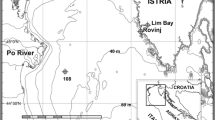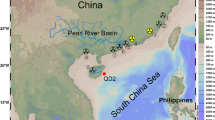Abstract
Assessing the impact of ionizing radiation on the marine environment requires a well-defined methodology, which includes, among other elements, the analysis of exposure and effects. One of the most important components of the assessment system is the choice of reference organisms specific for the assessed area that fulfill requirements such as radioecological sensitivity, widespread distribution, and amenability to research and monitoring. The following species specific to the southern Baltic Sea that represent diversified ecological niches were proposed as reference organisms. Polysiphonia fucoides was proposed as a representative of macroalgae. Pelagic and benthic fauna were represented by Crangon crangon (crustacean), Saduria entomon (crustacean), Hediste diversicolor (polychaete), and Mytilus trossulus (mollusc). Fish were represented by Clupea harengus (pelagic planctotrophic fish), Gadus morhua (pelagic carnivorous fish), and Platichthys flesus (benthic fish). Activity concentrations of 137Cs were determined in reference biota as well as in seawater, as required for the total dose-rate evaluation, and relevant concentration factors were calculated.
Similar content being viewed by others
References
Bé, M.-M., Chisté, V., Dulieu, C., Browne, E., Baglin, C. et al., 2008, Monographie BIPM-5, Tables of Radionuclides (Comments on evaluation), Vol. 1–4, Bureau International des Poids et Measures, Pavillon de Breteuil, F-92310 Sevres.
Brown J.D., Hosseini A., Borretzen P., Thorring H., 2006, Development of a methodology for assessing the environmental impact of radioactivity in Northern Marine environments, Mar. Pollut. Bull., 52:1127–1137.
Burger J., Gochfeld M., Jewett S., 2006, Selecting species for marine assessment of radionuclides around Amichitka: planning for diverse goals and interests, Environ. Monit. Assess., 123: 371–391.
HELCOM, 1995, Radioactivity in the Baltic Sea 1984–1991, Baltic Sea Environment Proceedings, No 61: 59–68
HELCOM, 2003, Radioactivity in the Baltic Sea 1992–1998, Baltic Sea Environment Proceedings, No 61: 5–15.
HELCOM, 2009, Radioactivity in the Baltic Sea 1999–2006, Baltic Sea Environment Proceedings, No 117: 47–49.
IAEA, 2005, Worldwide Marine Radioactivity Studies -WOMARS, Radionuclides Levels in Oceans and Sea, IAEA-TECDOC-1429, ISBN 92-0-114904-2, pp.125.
IAEA, 2010, HELCOM-MORS Proficiency Test Determination of Radionuclides in Fish Flesh Sample, IAEA/AQ/13, ISSN 2047-7659.
ICRP, 1991, Recommendations of the International Commission on Radiological Protection, Publication 60, Annals of the ICRP 21, Oxford Pergamon Press, Oxford.
IMGW, 2004–2006, Southern Baltic Sea — Environmental conditions in 2004 (.....2006), M. Miętus, E. Łysiak-Pastuszak, T. Zalewska, W. Krzymiński (eds.), Institute of Meteorology and Water Management, Maritime Branch in Gdynia, Warsaw 2010 (in Polish with English summary).
Ikaheimonen T.K., Outola I., Vartti V.-P., Kotilainen P., 2009, Radioactivity in the Baltic Sea: inventories and temporal trends of 137 Cs and 90Sr in water and sediments, J. Nucl. Radioanal. Chem., 282(2): 419–425.
Jones, C., Gilek, M., 2004, Overview of programmes for the assessment of risks to the environment from ionizing radiation in European ecosystems — an overview, J. Radiol. Prot., 24(4): A157–A177.
Jones. D., Domotor, S., Higley, K., Kocher, D., Bilyard, G., 2003, Principles and issues in radiological ecological risk assessment, J. Environ. Radioac., 66: 19–39.
Kumblad L., Kautsky U., Naeslund B., 2006, Transport and fate of radionuclides in aquatic environments-the use of ecosystem medelling for exposure assessments of nuclear facilities, J. Environ. Radioac., 87: 107–129.
Lepicard S., Heling R., Maderich V., 2004, POSEIDON/RODOS models for radiological assessment of marine environment after accidental releases: application to costal areas of the Baltic, Black and North Seas, J. Environ. Radioac., 72: 153–161.
Nielsen S.P., Bengston P., Bojanowski R., Hagel P., Herrmann J. et al., 1999, The radiological exposure of man from radioactivity in the Baltic Sea, Sci. Tot. Environ., 237/238: 133–141.
Sazykina, T.G., Jaworska, A., Brown, J.E. (Eds.), 2003, Dose-effects relationships for reference (or related) Arctic biota. Deliverable Report fro EC Inco-Copernicus project EPIC (ICA2-CT-2000-10032), Norwegian Radiation Protection Authority, Osteras, Norway.
Zalewska T., Lipska J., 2006, Contamination of the southern Baltic Sea with 137 Cs and 90 Sr over the period 2000–2004, J. Environ. Radioac., 91: 1–14
Zalewska T., Saniewski M., 2011a, Bioaccumulation of 137 Cs by benthic plants and macroinvertebrates, Oceanological and Hydrobiological Studies, doi:10.2478/s13545-011-0023-6
Zalewska T., Saniewski M., 2011b, Bioaccumulation of gamma emitting radionuclides in red algae from the Baltic Sea under laboratory conditions, Oceanologia, doi:10.5697/oc.53-2.631
Zalewska T., 2011, Seasonal changes of 137 Cs in benthic plants from the southern Baltic Sea, Journal of Radioanalytical and Nuclear Chemistry, doi: 10.1007/s.10967-011-1546-4.
Zalewska T., 2012a, Seasonal changes of 137 Cs in benthic plants from the southern Baltic Sea, Journal of Radioanalytical and Nuclear Chemistry 292:211–218, doi: 10.1007/s.10967-011-1546-4.
Zalewska T., 2012b, Distribution of 137 Cs in benthic plants along depth profiles in the outer Puck Bay (Baltic Sea), Journal of Radioanalytical and Nuclear Chemistry, doi: 10.1007/s.10967-012-1723-0.
Author information
Authors and Affiliations
Corresponding author
About this article
Cite this article
Zalewska, T., Suplińska, M. Reference organisms for assessing the impact of ionizing radiation on the environment of the southern Baltic Sea. Ocean and Hydro 41, 1–7 (2012). https://doi.org/10.2478/s13545-012-0033-z
Received:
Accepted:
Published:
Issue Date:
DOI: https://doi.org/10.2478/s13545-012-0033-z




